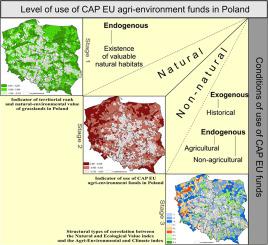Land Use Policy ( IF 6.0 ) Pub Date : 2021-06-03 , DOI: 10.1016/j.landusepol.2021.105574 Łukasz Wiśniewski , Roman Rudnicki , Justyna Chodkowska-Miszczuk

|
While the European Union’s Common Agricultural Policy (EU CAP) is being redefined, natural habitats, treated as wasteland for many years, are becoming a crucial element in the promotion of environmentally-friendly management of farmland and the protection of biodiversity and the local cultural landscape. The aim of the study is to assess the effectiveness of the uptake of certain environmental CAP funds and to describe the factors behind the spatial differentiation of the uptake of these funds. Both natural and non-natural conditions are taken into account. The analysis is conducted for Poland, a country engaged in reform of the agricultural economy, which has sizeable areas of habitats of high value for nature and which represents a region of Europe in need of special public support for environmental improvement. The research procedure consisted of the following four main stages: (1) spatial delimitation of grasslands (taking into account their territorial rank and quality) and (2) the level of utilisation of funds under specific Agri-Environmental and Climate Schemes (AECSs), (3) determining the relationships – types and (4) identifying the causes of disproportions, taking into account selected non-natural conditions. Apart from indicator methods, use is made of spatial typology and spatial autocorrelation methods (global and local Moran I coefficients). The results of the analysis show the decisive influence of natural and environmental conditions on the amount of funds expended through AECSs. However, the study has also identified situations where non-natural factors come to the fore. Among the non-natural conditions, a key role is played by historical factors. The study has identified areas with untapped environmental potential and those where environmental farming measures are underutilised given the environmental potential of those areas. The situation described is detrimental to the effectiveness of support, which is contrary to CAP principles. The findings are important in the context of monitoring and evaluating the EU’s agricultural policies, which should take more account of the characteristics of the individual countries, including their natural regional and local specificities.
中文翻译:

在具有宝贵栖息地的地区,欧盟 CAP 资金使用不足的背后有哪些非自然因素?
在重新定义欧盟共同农业政策 (EU CAP) 的同时,多年来被视为荒地的自然栖息地正在成为促进农田环境友好管理以及保护生物多样性和当地文化景观的关键因素. 该研究的目的是评估某些环境 CAP 资金的吸收有效性,并描述这些资金吸收空间差异背后的因素。考虑了自然和非自然条件。该分析是针对波兰进行的,波兰是一个从事农业经济改革的国家,该国拥有大量对自然具有高价值的栖息地,代表了一个需要特别公共支持来改善环境的欧洲地区。研究程序包括以下四个主要阶段:(1)草原的空间划定(考虑其领土等级和质量)和(2)特定农业环境和气候计划(AECS)下的资金利用水平, (3) 确定关系 - 类型和 (4) 确定不成比例的原因,同时考虑选定的非自然条件。除了指标方法外,还使用空间类型学和空间自相关方法(全局和局部 Moran (3) 确定关系 - 类型和 (4) 确定不成比例的原因,同时考虑选定的非自然条件。除了指标方法外,还使用空间类型学和空间自相关方法(全局和局部 Moran (3) 确定关系 - 类型和 (4) 确定不成比例的原因,同时考虑选定的非自然条件。除了指标方法外,还使用空间类型学和空间自相关方法(全局和局部 Moran一世系数)。分析结果表明,自然和环境条件对通过 AECS 花费的资金量具有决定性影响。然而,该研究还确定了非自然因素出现的情况。在非自然条件中,历史因素起着关键作用。该研究确定了具有未开发环境潜力的地区,以及鉴于这些地区的环境潜力而未充分利用环境农业措施的地区。所描述的情况不利于支持的有效性,这与 CAP 原则背道而驰。调查结果在监测和评估欧盟农业政策的背景下很重要,应该更多地考虑各个国家的特点,











































 京公网安备 11010802027423号
京公网安备 11010802027423号